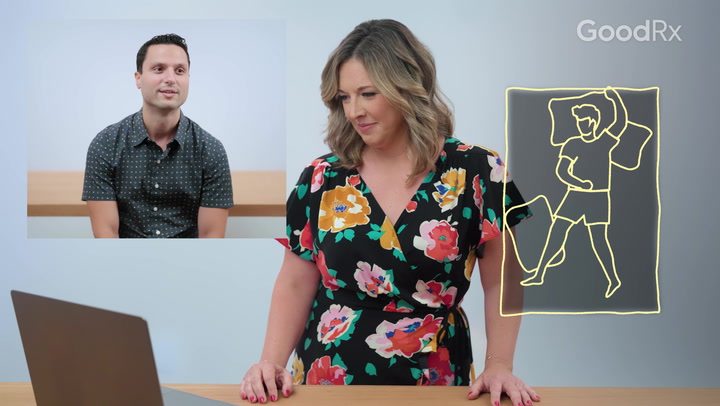
What Is Sleep Paralysis? Symptoms, Causes, and Treatment Options
Key takeaways:
Sleep paralysis is a parasomnia (a type of sleep disorder) that keeps you from moving or speaking when you first wake up.
You’re more likely to develop sleep paralysis if you have poor sleep quality, an underlying sleep disorder, or if the condition runs in your family.
Sleep paralysis is not dangerous. But it can be a sign of another sleep disorder that may need treatment.

Have you ever woken up and been unable to move or speak? If so, you may have experienced sleep paralysis, a type of parasomnia. Parasomnias are sleep disorders that cause unusual symptoms while you’re asleep or as you fall asleep or wake up.
Sleep paralysis affects around 8% of adults at some point in their lifetime. Although it can be quite frightening, it’s not usually a cause for concern. But it can be a sign of another sleep disorder that may need medical attention. Here’s what you need to know if you’ve been experiencing sleep paralysis.
What is sleep paralysis?
Sleep paralysis is when you can’t move or speak when you first wake up or when you’re starting to fall asleep. You feel “awake,” but you can’t move at all.
Search and compare options
This typically happens when you’re going into or coming out of REM sleep — the stage where most dreaming happens. When you’re in REM (rapid eye movement) sleep, your brain signals your muscles to relax. This is called REM atonia, and it’s a safety mechanism that helps prevent you from acting out your dreams.
REM atonia should start when you’re asleep and stop as soon as you’re conscious. If it starts too early or lasts too long, you can experience sleep paralysis.
Sleep paralysis can start at any age. Most people experience their first episode of sleep paralysis as a teenager. But it tends to happen more often when people are in their 20s and 30s.
What are the symptoms of sleep paralysis?
People with sleep paralysis report being awake and experiencing some or all of these symptoms:
Inability to move or a feeling of being “frozen”
Inability to speak
Helplessness
Fear
Panic
Throat tightening
A sense of impending doom
A need run away
Many people also report that they sense that someone or something is present in the room with them during episodes of sleep paralysis.
Read more like this
Explore these related articles, suggested for readers like you.
What does sleep paralysis feel like?
People often feel intense fear and anxiety along with sleep paralysis. After all, it can be scary to feel like you can’t move your muscles or talk, especially if you also sense that something or someone is in your room.
Some people with sleep paralysis also have hallucinations, which are often described as “dream-like.” Many people report at least partially understanding that they’re hallucinating. But when this happens, they feel like they can’t control it or do anything about it.
How long does sleep paralysis last?
Episodes of sleep paralysis can last anywhere from a few seconds to a few minutes. Most episodes end on their own. But sometimes an episode can end more quickly when someone touches or talks to you.
You might even be able to stop a sleep paralysis episode by making your best effort to move.
How do you wake up from sleep paralysis?
You will wake up naturally from sleep paralysis. This can take a few minutes, and that time can seem endless when you’re frightened. Many people realize they’re having an episode of sleep paralysis and can learn how to wake themselves up.
Here are some tips that can help you with your next episode:
If you sleep in a room with someone, let them know you have episodes of sleep paralysis. That way they can wake you up with touch or their voice if they think you’re having an episode.
Recognize that you’re having an episode of sleep paralysis. Most people can tell they are in the middle of an episode. The first step in waking yourself up is realizing that your symptoms are from sleep paralysis.
Once you’re aware of your episode, try to move. Focus on moving a small muscle, like a toe or finger. This can be very hard to do, but movement can trigger your body to wake up.
Breathe slowly and settle your mind. Panic and fear may worsen your symptoms during sleep paralysis.
What causes sleep paralysis?
It’s not clear what causes sleep paralysis. But research shows that people are more likely to develop sleep paralysis if they:
Have an anxiety disorder
Have poor sleep quality
Drink alcohol before sleep
Have a history of traumatic events
Sleep paralysis can also be a sign of an underlying sleep disorder, like narcolepsy (a condition that causes extreme daytime sleepiness) or insomnia.
Sleep paralysis can also run in families. In a 2015 study, scientists collected data from 862 siblings and twins about their sleep quality, anxiety symptoms, and exposure to trauma. They found that people had a 53% likelihood of having sleep paralysis if someone in their family also experienced it.
Is sleep paralysis dangerous?
Sleep paralysis is not dangerous. But experiencing the symptoms of sleep paralysis can be terrifying. Some people experience frequent episodes of sleep paralysis. These people are at higher risk of developing anxiety about falling asleep. And this can lead to insomnia and sleep deprivation.
When should you talk to a healthcare provider about sleep paralysis?
You should talk with a healthcare provider if:
You’re experiencing sleep paralysis more than once a month.
The episodes make you so frightened or anxious that you can’t fall asleep at night.
The episodes are interfering with your daily life.
You should also talk to your healthcare provider if you have any symptoms of narcolepsy along with sleep paralysis, like:
Fragmented (broken) sleep
A feeling of being overly sleepy during the day
Hallucinations
How do you diagnose sleep paralysis?
Your healthcare provider can diagnose sleep paralysis based on your symptoms. But they may also recommend a sleep study, which can identify other sleep disorders.
A sleep study (polysomnogram) monitors your brain waves, breathing, as well as eye and body movements while you sleep. You can do a sleep study at home or at a sleep center.
How do you treat sleep paralysis?
Many people want to know how to stop sleep paralysis. But many things trigger sleep paralysis. The first step to stopping sleep paralysis is finding your triggers and then addressing them. Improving your overall sleep quality can also lower the number of episodes of sleep paralysis that you experience.
Here are some tips from the National Library of Medicine for more restful sleep:
Go to bed at the same time every night, and wake up at the same time each morning (including on weekends).
Stop using electronics at least 30 minutes before bedtime. Ideally, leave electronics out of your bedroom altogether.
Limit caffeine and alcohol consumption, especially later in the day.
Make sure your mattress and bedding are comfortable.
Get blackout curtains, and minimize the amount of light and noise in your bedroom as much as possible.
Aim for at least 7 to 9 hours of sleep each night.
If you’ve been diagnosed with another sleep condition, make sure to start treatment. Getting help for an underlying sleep condition can help improve sleep paralysis.
The bottom line
Sleep paralysis is a type of parasomnia where you can’t move when you first wake up or when you start to fall asleep. Although these episodes can be frightening, they’re usually not a serious problem. But if you have frequent episodes or other sleep problems, talk to a healthcare provider. To prevent sleep paralysis, it can be helpful to take steps to improve the quality of your sleep, like avoiding alcohol, caffeine, and electronics before going to bed.
Why trust our experts?


References
American Academy of Sleep Medicine. (2020). What is sleep paralysis?
Breus, M. (2022). Sleep paralysis. The Sleep Doctor.
Denis, D., et al. (2015). A twin and molecular genetics study of sleep paralysis and associated factors. Journal of Sleep Research.
Farooq, M., et al. (2022). Sleep paralysis. StatPearls.
Jalal, B. (2018). The neuropharmacology of sleep paralysis hallucinations: Serotonin 2A activation and a novel therapeutic drug. Psychopharmacology.
National Institute of Neurological Disorders and Stroke. (2023). Narcolepsy.
Suni, E. (2023). Sleep paralysis: Symptoms, causes, and treatment. Sleep Foundation.
Wróbel-Knybel, P., et al. (2020). Prevalence and clinical picture of sleep paralysis in a Polish student sample. International Journal of Environmental Research and Public Health.




























